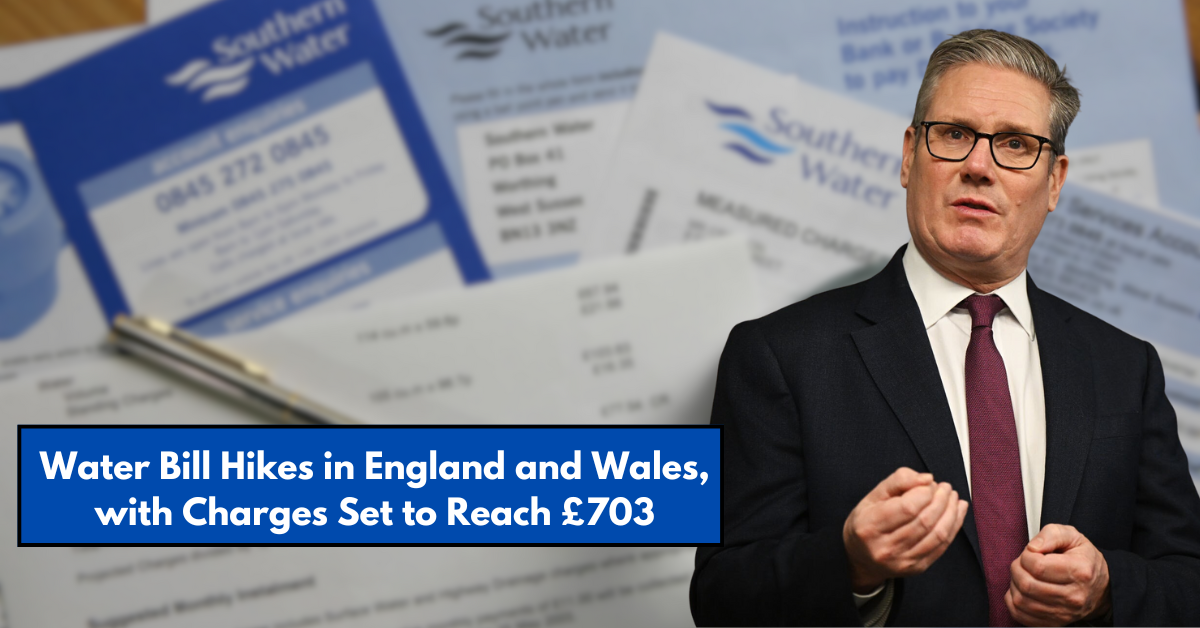Starting from April 2025, residents in England and Wales will face a substantial increase in their water bills. The average bill is expected to rise by 26%, amounting to an additional £123 annually.
This increase will affect millions of households, with some areas facing even higher charges. Here’s a breakdown of the upcoming changes and what they mean for you.
Average Water Bill Increases
The price hikes will affect water bills across England and Wales, with the average household seeing a rise of £123 in their annual water bill. This brings the average bill to £603.
However, depending on where you live, your water bill could go as high as £703. Customers in certain regions like Southern Water, Thames Water, and Yorkshire Water will face some of the highest increases.
Southern Water customers will experience a staggering 47% increase in their bills, with an average annual water bill of £703.
Other water companies like Hafren Dyfrdwy and South West Water will see increases of 32%, while Thames Water bills will rise by 31%. Customers of Yorkshire Water will face a 29% rise.

Why Are Water Bills Rising?
The main reason for this price hike is inflation. The Consumer Prices Index (CPI) has been used to adjust the bills for inflation.
Ofwat, the industry regulator, had already set price limits for water companies before Christmas 2024, but these increases go beyond those limits due to inflationary pressures.
Water UK, the industry body, has acknowledged that this rise will be challenging for many households, especially those already struggling financially.
Despite the increase, the water companies are planning to make significant investments in infrastructure to improve water supply and sewage systems.
In 2025-26, water companies are expected to invest a historic £20 billion to improve the quality of water, secure water supplies, and eliminate sewage discharge into rivers and seas.
Impact on Southern Water and Other Areas
Southern Water customers will be hit particularly hard, with an average increase of £703 in their annual water bill. This is the highest rise in the country and is part of a broader trend where many regions will see significant hikes.
The increase of 47% for Southern Water customers is the steepest, followed by 32% increases for other companies like Hafren Dyfrdwy and South West Water.
While the increases will vary depending on the region, there is a general trend of rising prices across the country. The increase will be particularly difficult for low-income households and pensioners who are already grappling with higher living costs.
The Consumer Council for Water (CCW) has urged for more support for vulnerable customers who will be hit hardest by these increases.
The Privatisation Debate
The water industry in England and Wales has been privatized for 36 years, and this increase is seen by some as the latest consequence of that privatization.
The industry has faced significant criticism for neglecting infrastructure and burdening itself with billions in debt, leading to increased water bills for consumers.
Campaign groups like River Action have called for stronger action to hold water companies accountable for their failures and for greater investment in improving water infrastructure.
Critics argue that consumers are being forced to bear the cost of a system that prioritizes profits over public service.

What Can Customers Do?
As water bills rise, customers are advised to contact their water companies for help if they’re struggling to pay their bills.
The CCW has highlighted that many households are already in debt to water companies, and there is a risk that this number will increase unless companies provide more support.
Water companies have been urged to offer better assistance to customers, especially those facing financial hardships. In addition, customers can apply for social tariff schemes, which provide financial help to those on low incomes.
However, the availability of these schemes varies widely across regions, and some households may not qualify for support.
Looking Ahead: What’s Next?
The water industry has promised significant investments in the coming years, with plans to invest £20 billion in infrastructure improvements by 2025-26.
These investments aim to improve the quality of water, ensure a more secure water supply, and address environmental concerns such as sewage discharge.
However, these improvements will take time to materialize, and for now, customers will have to deal with the immediate impact of rising water bills.
It is essential for households to plan ahead and consider ways to manage the increased cost of living, including reviewing their water usage and applying for financial assistance if eligible.
Conclusion
Starting in April 2025, water bills in England and Wales will increase by an average of 26%, with some areas seeing even steeper hikes. Southern Water customers, in particular, will face the highest increases, with their bills rising by 47%.
While the price hikes are due to inflation and rising costs, water companies are making significant investments in infrastructure to improve water services.
However, the rising bills are causing concern, especially for households already struggling with high living costs. Customers are encouraged to seek assistance and explore available support options to help manage the increase in water bills.
This article has been carefully fact-checked by our editorial team to ensure accuracy and eliminate any misleading information. We are committed to maintaining the highest standards of integrity in our content.

Filza specializes in simplifying financial topics for everyday readers. Whether breaking down Canada’s tax guides or U.S. benefits like SNAP and VA Disability, Filza’s relatable writing style ensures readers feel confident and informed. Follow her insights on LinkedIn or reach out via email at [email protected].




